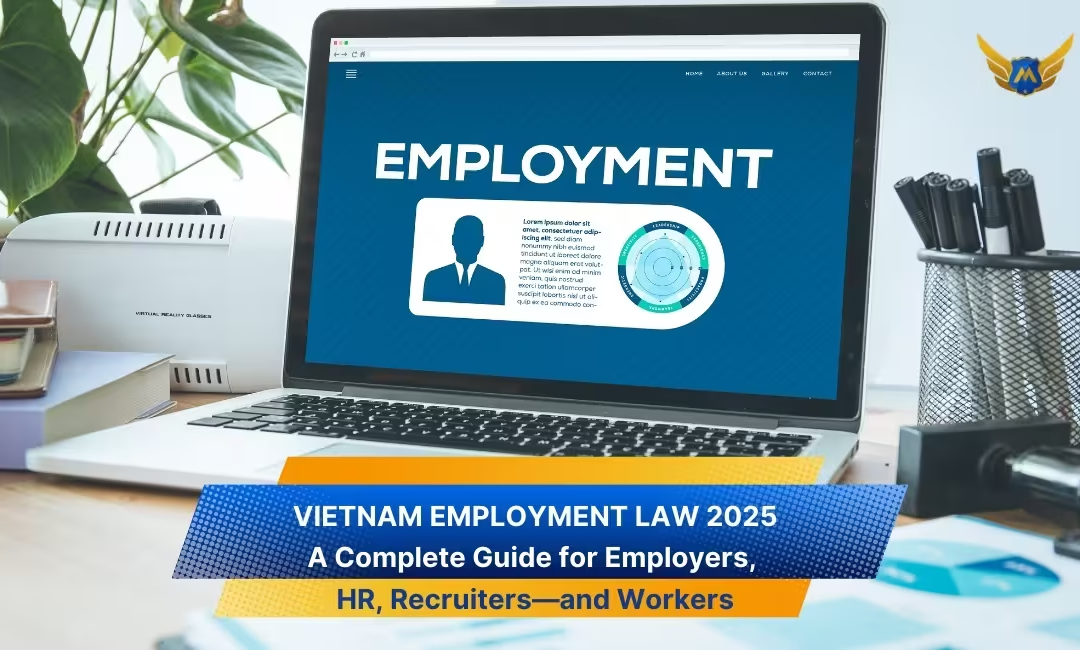Executive Overview (read this first)
- What changed: Vietnam enacted the Employment Law 2025 (No. 74/2025/QH15)—a major update replacing the 2013 regime. From January 1, 2026, the law overhauls unemployment insurance (UI), introduces a National Labor Registration Database, and tightens data-handling duties in HR.
- Why it matters: The law broadens UI coverage, gives the Government flexibility to set employer UI up to 1%, and hardwires labor-market data reporting. HR must realign payroll, privacy notices, e-contracts, and vendor controls.
- Who’s impacted: Not only FDI manufacturers and tech firms—all employers (SMEs, NGOs, staffing/PEO/outsourcing platforms) and workers (including part-time and short-term contracts) will interact with new UI and data rules.
What’s New vs. Previous Rules (Side-by-Side Snapshot)

Before (2013 framework)
- UI contributions fixed at 1% employee / 1% employer; narrower coverage.
- No unified national labor registration database; reporting fragmented.
- E-contracts valid but implemented unevenly.
- Data privacy guided mainly by sectoral laws and the 2023 PDP Decree.
Now (Employment Law 2025 from 1/1/2026)
- UI coverage expands to additional categories (e.g., certain short-term and part-time roles; salaried enterprise/co-op managers).
- Employer UI = up to 1% (variable; Government may set below the ceiling).
- Launch of a National Labor Registration Database and Labor-Market Information System with employee rights to access/correct their records.
- Data obligations rise alongside the new Personal Data Protection Law (effective 2026), on top of existing privacy rules.
- Clearer recognition and usage norms for electronic labor contracts and audit-worthy e-signatures.
10 Big Changes—With Plain-English HR Actions

- UI coverage widens
- What changed: More worker types become UI-eligible, closing gaps for short-term and certain part-time roles and managerial positions on salary.
- Action: Remap your workforce in HRIS. Tag newly covered groups; update onboarding and payroll eligibility logic.
- Employer UI becomes “up to 1%”
- What changed: Instead of a fixed 1%, the Government can set the employer rate up to 1% and reduce it in special conditions.
- Action: Build a rate toggle in payroll (scenarios at 0.5%–1.0%). Update budget models and HR cost communications.
- UI salary basis expands
- What changed: UI may count salary plus regular allowances/other fixed payments (where applicable), not only the base used for SI.
- Action: Review compensation structures; mark which allowances are “regular” for contribution purposes; align payslip breakdowns.
- Make-good liability for missed UI
- What changed: If an employer fails to contribute, they must compensate the worker for the benefits they should have received (allowances, training support, health insurance during unemployment, etc.), plus penalties under Social Insurance law.
- Action: Establish monthly exception alerts and a fast remediation workflow with Legal sign-off.
- National Labor Registration Database (NLRD)
- What changed: A unified database requires employers to register/update employee information; workers can access and correct their records.
- Action: Assign a Data Steward; run a monthly sync from HRIS to the NLRD; train HR on rectification processes.
- Data privacy duties intensify (2026)
- What changed: Vietnam’s new Personal Data Protection Law (effective 2026) strengthens rights, lawful bases, DPIAs, and cross-border controls—on top of PDP Decree 13/2023.
- Action: Update the Employee Privacy Notice, registers of processing, DSR (Data Subject Request) SOPs (e.g., 15-day SLA), encryption/retention rules, and international transfer assessments.
- Electronic labor contracts are mainstream
- What changed: E-contracts concluded via electronic data messages remain valid; the 2023 E-Transactions Law clarifies scope and signature recognition.
- Action: Standardize e-contract templates; require verified e-signature; keep hash/audit logs; bilingual templates for foreign hires.
- UI benefits & eligibility modernization
- What changed: Rules for benefit calculation and qualifying periods are clarified, including treatment of short-term contracts.
- Action: Build an eligibility calculator; educate employees at exit interviews; ensure certificate/insurance documents are complete.
- Incentives and exclusions refined
- What changed: Targeted provisions (e.g., potential contribution relief for hiring people with disabilities; refined exclusions such as pension-eligible workers).
- Action: Update policy memos and edge-case checklists (probationers, unpaid ≥14 working days, etc.).
- Closer integration with SHUI & payroll controls
- What changed: UI caps tie to regional minimum wages; SI/HI caps remain tied to the statutory base salary.
- Action: Parameterize caps in payroll by Region (I–IV) and by the latest statutory base. Re-train payroll on cap logic and audits.
Numbers That Matter (Caps & Examples)

- UI cap: Calculated up to 20× regional minimum wage.
Illustration (Region I): cap ≈ VND 99,200,000. - SI & HI caps: Calculated up to 20× the statutory base salary (currently VND 2,340,000, i.e., cap VND 46,800,000).
Quick illustration A (Region I, gross 50,000,000 VND):
- UI base = 50,000,000 (below the 99.2m cap).
- Employee UI 1% = 500,000; Employer UI up to 1% (example at 1%) = 500,000.
- SI/HI bases apply separately (capped at 46.8m for SI/HI).
Quick illustration B (Region I, gross 120,000,000 VND):
- UI base capped at 99,200,000 → Employee UI 1% = 992,000; Employer UI up to 1% (illustrative) = 992,000.
- SI/HI base capped at 46,800,000 as per statutory base multiplier.
(Note: “Employer up to 1%” means the Government may set a lower rate; model 0.5%–1.0% to be safe.)
30–60–90 Day Compliance Plan (Start now; go-live Jan 1, 2026)

Day 0–30 — Assess & Design
- Run a UI eligibility map across all worker types (incl. short-term/part-time; managerial positions on salary).
- Draft an Employee Privacy Notice, Processing Register, and DSR SOP; list all cross-border flows.
- Review e-contract stack: templates, bilingual needs, e-signature vendor due diligence, preservation of audit trails.
Day 31–60 — Build & Implement
- Configure payroll for UI employer-rate variability and caps by region; set exception alerts for missing UI.
- Stand up the NLRD monthly sync process; designate a Data Steward and escalation paths.
- Launch reskilling catalog (digital skills, safety, supervisory) to align with UI employability goals.
Day 61–90 — Test & Certify
- Table-top drill: simulate a Data Subject Request (access/correction/deletion where applicable) and log proof.
- Mini-audit: sample contracts, check UI payment proofs, verify payroll cap logic and NLRD records; remediate before year-end.
Practical Playbooks by Stakeholder
FDI and large domestic employers
- Integrate HRIS with payroll and government portals; maintain a privacy operating model (RACI across HR–Legal–IT) and quarterly controls testing.
- Set up early-warning dashboards for UI underpayments, missing registrations, and overdue DSRs.
SMEs and high-growth startups
- Use a single HR/payroll suite; keep a lean processing register (who/what/where/why/how long) and a simple DSR log.
- Outsource an annual compliance review; adopt one reputable e-signature provider.
Recruiters, staffing firms, PEO/EOR, platforms
- Update client onboarding checklists to verify UI configuration and data notices.
- Ensure brokered candidates receive clear privacy disclosures; standardize e-contract workflows with audit trails.
Employees and jobseekers
- Review your insured salary on payslips; keep records of contributions.
- Understand UI eligibility, including benefit calculation and deadlines; exercise your data rights to access/correct NLRD entries.
Deeper Dive: Unemployment Insurance (UI) Rules that Trip Teams Up

- Coverage scope: Includes more worker categories than before; foreign employees remain generally exempt from UI under current rules.
- Contribution rates: Employee 1%; Employer up to 1% (Government-set; may adjust in crises). The State may support up to 1% from the budget.
- Salary basis: UI calculated on salary plus regular allowances (where applicable), subject to regional caps (20× minimum wage).
- Eligibility & benefits: Unemployment allowance typically 60% of the average insured salary of the last 6 months, up to a cap linked to regional minimum wage; waiting periods and contribution history rules apply (short-term vs. longer contracts differ).
- Enforcement: If UI is unpaid/underpaid, employers must make employees whole for lost benefits and face sanctions under Social Insurance law.
- Special notes: Draft guidance has discussed temporary rate reductions (e.g., employee rate 0.9%) tied to fund balance—watch final Government decisions.
Deeper Dive: Data, Privacy & HR Tech
- National Labor Registration Database (NLRD): Employers must register and keep records current; employees can access and correct information; expect tighter data quality expectations.
- Personal Data Protection Law (effective 2026): Raises the bar on lawful bases/consent, impact assessments, security, and cross-border transfers—particularly relevant if you centralize HR data overseas or use foreign SaaS.
- Vendor & tool governance: Keep a list of HR tools, their data categories, storage locations, subprocessors, and retention. Build breach response muscle (roles, timelines, notifications).
Electronic Labor Contracts—Do Them Right
- Validity: E-contracts formed via electronic data messages have equal legal effect to written contracts, if executed under e-transactions rules.
- Execution hygiene: Use verified e-signatures; embed KYC where appropriate; store hashes/logs; maintain bilingual templates for foreign workers; document consent for data processing.

Risk Matrix (Condensed)
| Risk area | What can go wrong | Consequences | Control to implement |
|---|---|---|---|
| UI contributions | Missed/late payments; wrong base | Make-good to workers; penalties | Monthly exception report; cap logic tests |
| Data privacy | Missing notices/consents; cross-border gaps | Fines; orders to suspend processing | Privacy notice + lawful bases + DPIA |
| NLRD reporting | Incomplete/late updates | Compliance findings; inspections | Data Steward + monthly sync checklist |
| E-contracts | Weak e-signature/evidence | Disputes, invalidation risk | Vendor due diligence; audit logs, KYC |
| Offboarding | UI eligibility mishandled | Claims; delays, brand damage | Exit checklist incl. UI documents |
| Foreign staff | Wrong SHUI/UI assumptions | Over/under-payment; disputes | Separate playbook for foreigners |
FAQ about Vietnam Employment Law 2025
1) When does the new law take effect?
January 1, 2026. Plan and test changes in Q4/2025.
2) What’s the employer UI rate?
It can be up to 1% of the insured salary; the Government sets the actual rate and may adjust.
3) Which workers newly fall into UI?
Short-term and certain part-time arrangements and salaried enterprise/co-op managers are brought into scope, subject to detailed conditions.
4) Are foreign employees covered by UI?
Under current rules, foreign employees are generally exempt from UI. They still have Social and Health Insurance obligations where applicable.
5) How is unemployment allowance calculated?
Typically 60% of the average insured salary of the last six months, subject to a cap linked to the regional minimum wage, provided qualifying conditions are met.
6) What if my company missed UI payments?
You must compensate the worker for the benefits they should have received and may face penalties—hence the need for monthly exception checks.
7) Are e-contracts fully valid?
Yes—if concluded as electronic data messages and signed with recognized e-signatures, with audit-worthy preservation.
8) What data obligations change for HR?
You must keep workforce data accurate in the NLRD, honor employees’ access/correction rights, and meet higher privacy requirements under the 2026 PDP Law.
Having any concerns about New Employment Law in Vietnam 2025?
If you have anymore question / concern about New Employment Law in Vietnam 2025, please feel free to contact us or comment below for free support.
Email: admin@firstman.vn | Hotline / WhatsApp: +84-944-578-111 | Website: Firstman.asia | https://www.youtube.com/@firstman_vn
Sources (credible; list for your “References” box)
- Employment Law 2025 (Law No. 74/2025/QH15), effective 01/01/2026
- Decree No. 158/2025/ND-CP (guidance on employment/social insurance intersections)
- National Assembly and Vietnam News releases on labor registration database and employee rights to access/correct data
- Vietnam Social Security guidance on UI benefit formula and foreign-employee UI exemption
- EY Vietnam, Vision & Associates, and Vietnam Business Law client alerts (UI employer rate up to 1%, expanded coverage, salary basis)
- Labor Code 2019 (Article 14) and Law on E-Transactions 2023 (No. 20/2023/QH15) on electronic contracts and e-signatures
- Personal Data Protection Decree 13/2023 and Personal Data Protection Law (effective 2026)
Reference notes (for your review only — do not publish on the site)
- Law number & effective date; UI employer up to 1%; expanded coverage and salary basis; make-good for missed UI; database & data rights; e-contracts validity; PDP Law effective 2026; caps and examples are supported by: www.hoganlovells.com+8fidinam.com+8EY+8
- UI caps (20× regional minimum wage) and current region figures; SI/HI caps (20× statutory base): EY+2Vietnam Briefing+2
- Foreign employees exempt from UI; UI benefit formula (60% of last 6 months’ insured salary): VSS Portal+1
- Draft talk of 0.9% employee UI contribution under new decree (policy flexibility signal): VietNamNet News
- E-contract validity and LOET 2023 effective 1 Jul 2024: VBPL+1

